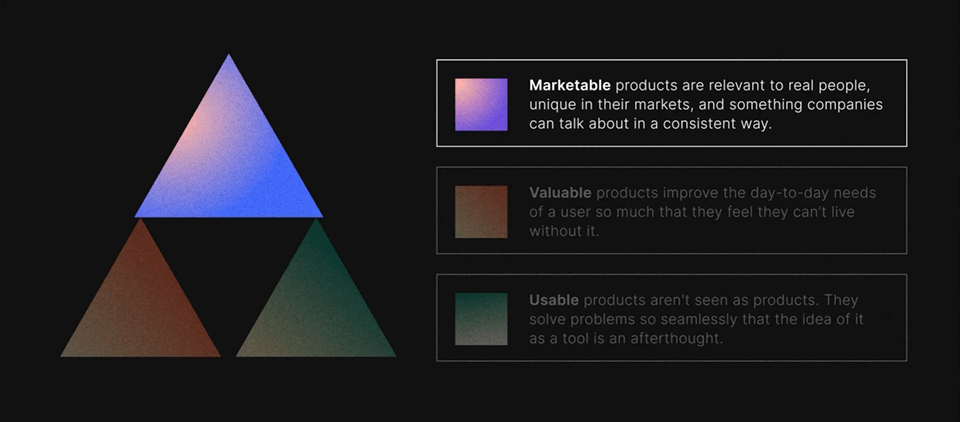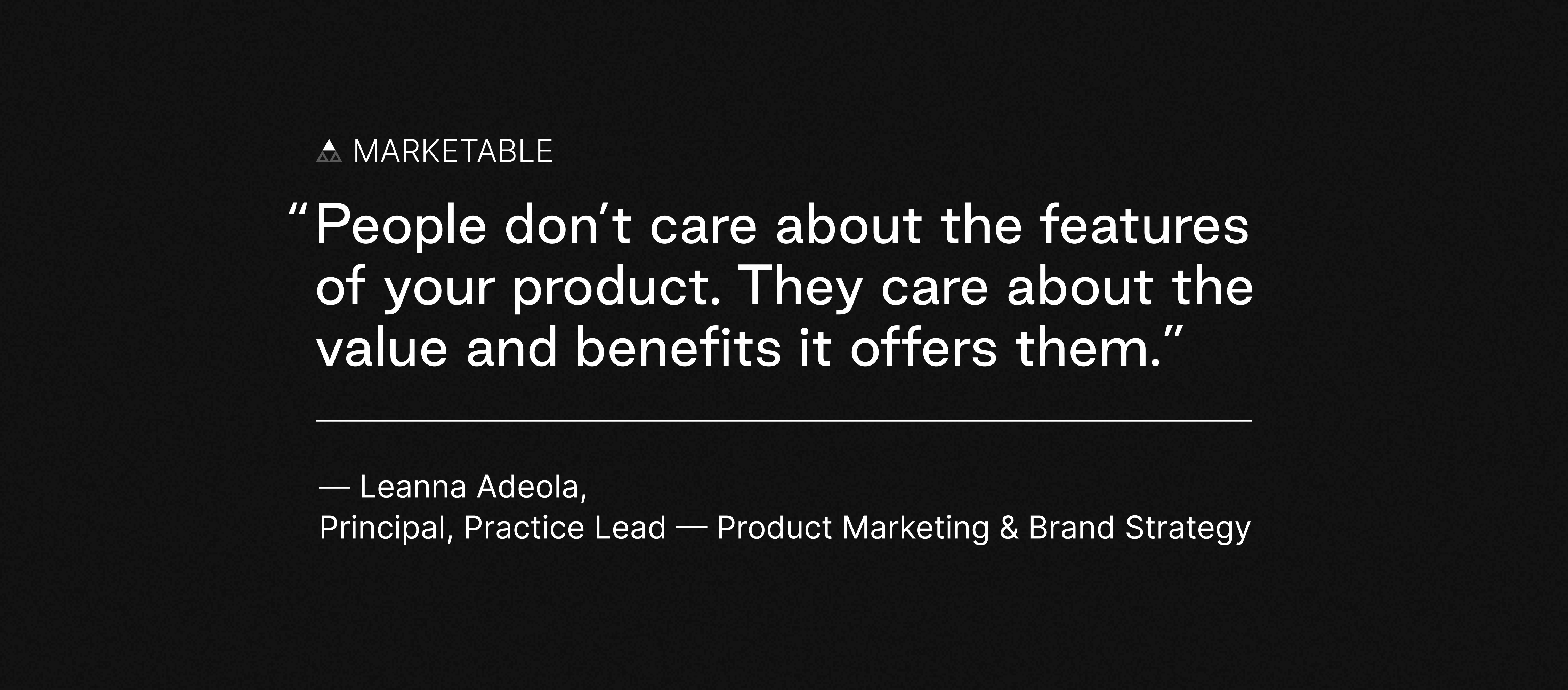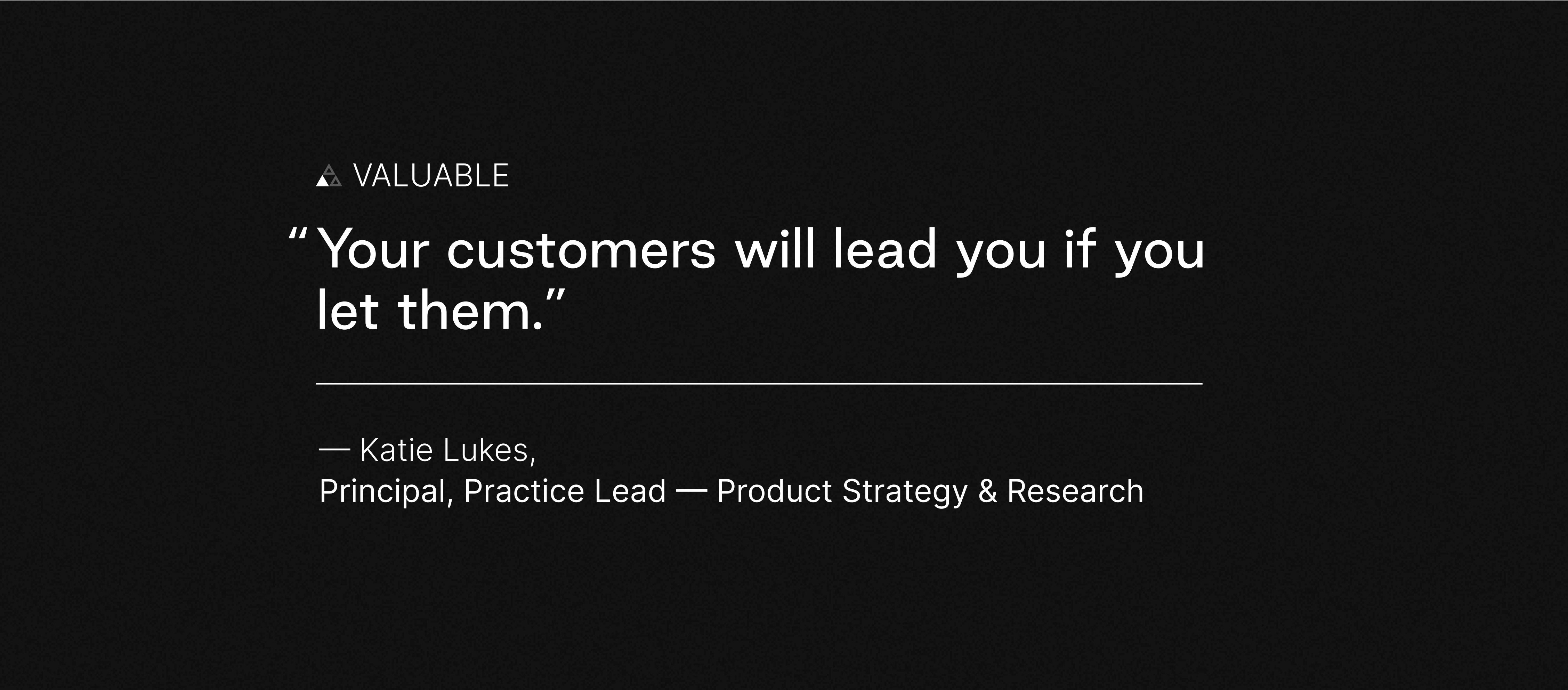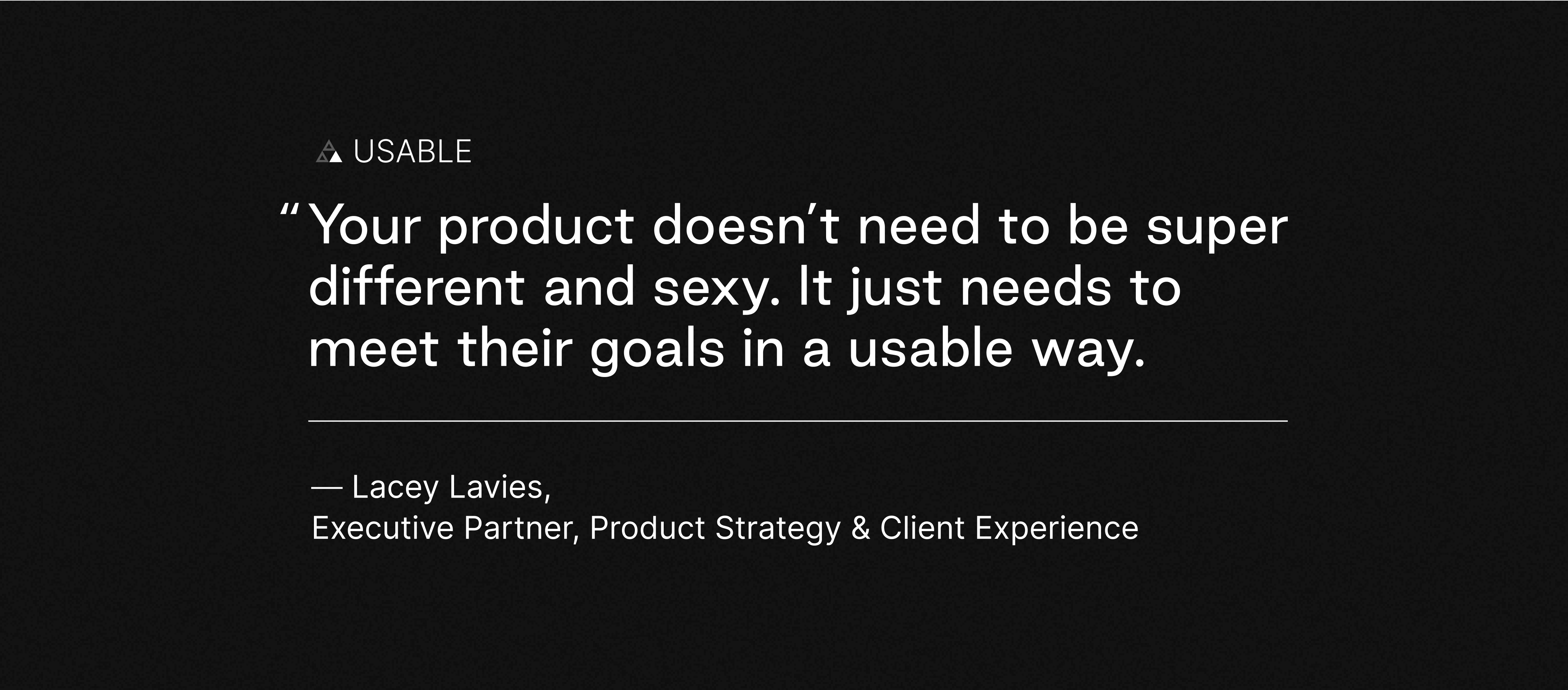

A better product is marketable, valuable and usable. In other words, a better product is an intuitive-to-use product that people will buy because it solves real problems.
Today’s consumer has high expectations for the products they use. It’s not enough to build the thing right with a scrappy team of qualified engineers — you need to build the right thing.
As a result, user experience is not a luxury, it’s table stakes. Product management is a must-have for pairing user goals with business goals to drive prioritization and build the right product. And product marketing is essential to create a consistent, relevant, and repeatable elevator pitch that you, your team and your customers can get behind.
While product marketing and brand experts make your product more marketable, product management and design experts make your product more valuable and usable.

Marketable
What Makes a Product Marketable
A marketable product is relevant, unique and shares a consistent message. If you’re struggling to craft a simple, clear description of what your product does and why it matters, your prospective customers are probably struggling too. By clearly explaining what you do and why people should care, you make it easier for people to understand and buy your product.
To find out if your product is marketable, ask:
- Is it relevant? Does your product solve a pain or problem that your audience cares about? Rather than highlighting what’s “cool” about your product, focus on what matters to the buyer. It’s tempting to tell them what you think they should care about, but that messaging won’t resonate with them.
- Is it unique? Can you state a unique benefit in market that other products can’t claim?
- Is your message consistent and accurate? Are you sharing a consistent and accurate message across all platforms about what your product is, who it serves and why they should use it?
If you answered no to any of these questions, you’re missing out on opportunities to capture the right buyers.
What Happens When Your Product Isn’t Marketable
If your product is not marketable, there will be internal and external downstream effects that will stunt growth and hurt sales.
Your product isn’t marketable if:
- People don’t easily and quickly understand what the product does.
- It takes a lot of time and education to tell people about your product.
- Your sales cycle is longer than other similar companies.
- You have high churn, either because you marketed to the wrong audience or you didn’t reinforce benefits to existing users.
- People are buying your product, but they’re not the ideal buyer.
- Everyone on your team explains your product in a different way.
- Your sales team relies solely on a product demo that isn’t working.
- You’re rewriting and reimagining messaging every time you need it for different use cases.
- Your Customer Acquisition Cost (CAC) is too high.
- Your sales team has no idea how to talk about the product, because you’ve launched or acquired a new product or they don’t have the tools they need to talk about its value.
- Prospects ask for collateral after a product demo.
How to Market a New Product
As you scale, so will your offerings. Whether you’re launching a new product or expanding your existing product suite, you’ll need a marketing strategy.
When marketing a new product:
- Be clear about your audience, what they care about and what they need. Often, companies launching a new product are really passionate about what they believe people care about. But it’s more important to describe your product and launch your product to resonate with what your audience wants and is looking for.
- Know how you’re different from others in market. If you’re launching in a crowded market, be explicit about how your value is different from competitors. If you’re unclear how you stand out, answer, “why should this audience in this industry buy my product right now?”
When to Pivot to a New Market
If you have an existing product and you want to pivot to a new market, you must know why you’re pivoting. It seems obvious, but pivoting markets is a huge shift for your business so you need to be intentional and confident.
There are a few triggers that may cause you to pivot:
- Your offerings have evolved. You can offer new and different value to your existing audience.
- Your audience has changed or expanded. There are new customers you want to serve.
- Your category or industry has changed. Markets, expectations and needs change, so you must evolve too.
Once you’ve identified why you’re pivoting, you can craft a path for what needs to happen next. You will likely need to evolve how you describe who you are, the features and benefits of your product and why it matters to your audience.

Valuable
What Makes a Product Valuable
A valuable product is indispensable. It solves real problems and meets user goals. Valuable products improve the day-to-day needs of users so much they feel that can’t live without it.
To find out if your product is valuable, ask:
- Does it solve real problems for real people? The product you want to build is useless if it doesn’t align with what users want to use. You want to solve real problems for real people, not hypothetical problems for hypothetical people.
- Is it clear and simple to use? If the product is confusing or unintuitive, it will fall flat with your users.
- Will people pay for it? Your product doesn’t matter if people aren’t willing to pay for it. If the product provides enough value, buyers will invest in it.
- Do users share and recommend it? Your users are your best salespeople because they come with no agenda. They want to talk about a great experience. Transform users into evangelists by creating a product that solves real problems and improves their lives. If you create a valuable product that truly impacts users, they can’t help but talk about it.
Remember, clear is kind. A valuable product is clear, simple and people just don’t want to be without it.
What Happens When Your Product Isn’t Valuable
When your product’s not valuable, it will either fail completely right away, or it will suffer a slow and painful downfall while soaking up all of your time, money and resources. Product development is expensive. If you’re going to build something, build the right thing.
Your product’s not valuable if:
- CAC is high and continues to increase.
- You aren’t seeing account growth and upgrades.
- You sell a big contract, but it doesn’t spread throughout the organization (you’re landing but not expanding).
- Users aren’t sharing the product with others.
- It’s hard to sell, and your sales team is finding problematic loopholes to make up for a lack of value.
- You have high employee turnover, especially in sales.
- Your engineers are determining and prioritizing features.
- You’ve been exploratory engineering, or building the product first and implementing design later.
- You’ve never talked to users or conducted research.
- Your roadmap is driven by what you assume is interesting or valuable.
How to Add Value to New Products
When building a product, it’s critical to keep value top of mind. Value can be created over time as you find new avenues to help users meet their goals in the best possible way, and with the least pain or frustration.
To keep value front and center, consistently ask:
- What problems does my audience have? Confirmation bias is the enemy of product market fit. If you’re building a product based on assumptions, you’ll waste time, money and resources building a product for hypothetical people. Find out from the source by studying buyer processes, pains and goals.
- What problems can we solve for them? How does what buyers need align with your solutions potential? How does it compare to other products in market?
- How can our product provide the most value to users? It’s easy to get overwhelmed trying to prioritize endless feature options. A value-driven strategy makes building your roadmap easier and creates the best product.
If you stray too far from what is valuable to your users and instead dream up features you’re passionate about, your product will quickly become useless. While you may like the product or features you’ve built, it doesn’t matter if your users won’t pay for it. Be proactive, clear and intentional about the value your product provides and the problems it solves.
How to Maximize Value in Existing Products
To maximize value in existing products, assess what you have today and determine if it’s meeting your user’s goals in the most effective way.
To meet needs in a better way, you must:
- Uncover unmet needs that your product can solve.
- Clearly define what users can achieve with the product.
- Make workflows more intuitive so users can accomplish tasks quickly.
If you find you’re not currently meeting user goals, use it as an opportunity to create value and add more depth by serving their needs in a better way.

Usable
What Makes a Product Usable
A product is usable when users don’t think about it while they’re using it.
It sounds counterintuitive, but as soon as your product is noticeable by the user, that generally means something is wrong. They’re noticing something in the workflow doesn’t quite work the way that it should, or it’s not optimized for their challenges.
To find out if your product is usable, ask:
- Is it intuitive? Can users easily and quickly accomplish necessary tasks without much help? The product experience should be seamless.
- Is it simple and clear? Do the workflows make sense and is it clear to the user what they are supposed to do at each step?
- Does it follow design patterns and industry trends to meet user expectations? Users expect products to work in certain ways. Following design trends and patterns can help you meet these expectations so your users don’t think about the product while they’re using it.
The most usable products are ones that you don’t notice. They work the way users expect them to so they don’t have to think about them.
What Happens When Your Product Isn’t Usable
If your product’s not usable, you’ll know quickly. Users won’t use, buy or share your product and your bottom line will suffer.
Your product’s not usable if:
- People don’t use it.
- Churn is high.
- It’s hard to scale.
- Customer success is swamped with support tickets.
- Internal teams aren’t proud of it and, as a result, sales struggles to sell it.
- You’ve got product debt, which becomes technical debt that’s hard to fix later.
- You have high employee turnover, especially in customer success.
- You have to create documentation or onboarding guides for users.
- People that were once eager to buy lose interest after using or seeing the product.
How to Build a Usable Product
When building a usable product, respect and use existing design patterns. Too often when building products, people attempt to be innovative for the sake of innovating (we call this innovation theater, and it’s unnecessary). Your product should follow what we call “UXpectations,” or existing design patterns that consumers have been trained to expect after years of using industry leading B2C products.
Design patterns exist because they work. They’re tried and true. If you use common, understood and accepted design patterns in your product, the product will be usable. Innovation is smaller than people assume.
By implementing design patterns and saving the innovation for smaller details throughout your product, you’ll build a much more cohesive and holistically innovative experience.
How to Optimize Usability
A product is optimized for usability when it fits directly into the user’s day-to-day workflow.
To find out if your product is optimized for usability, ask:
- Does it fit seamlessly into the user’s existing workflow? Your product shouldn’t disrupt the ways that users already work. Instead, it should complement, enhance and elevate existing workflows.
- Is it modern and does it meet UXpectations? Design affects credibility which is key to retaining users. If the product’s outdated, people won’t trust it. If it doesn’t work the way users expect, then they won’t use it.
- Can users get started without documentation, customer success or onboarding? Users should be able to accomplish tasks easily, quickly and without assistance.

See how we can help you build and market your digital product.

